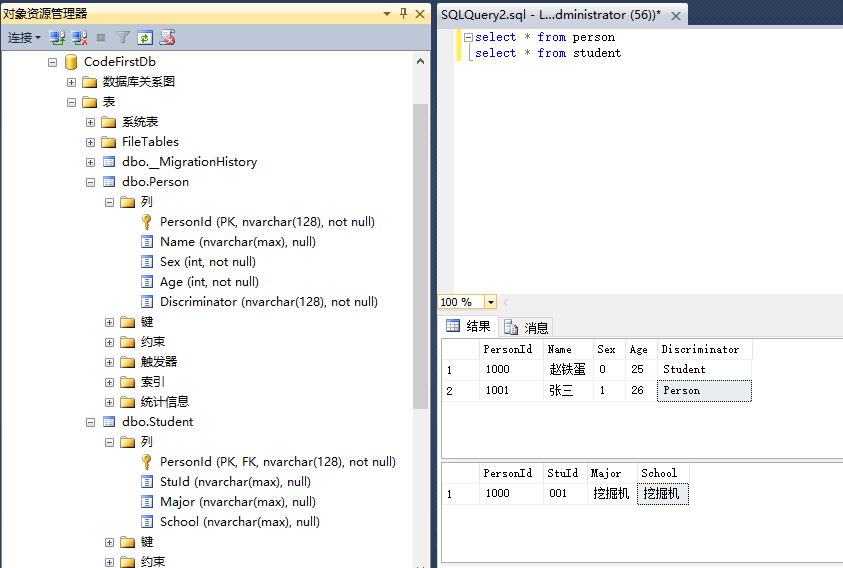在codefirst一中也说了Mapping是实体与数据库的纽带,model通过Mapping映射到数据库,我们可以从数据库的角度来分析?首先是映射到数据库,这个是必须的。数据库里面一般包括表、列、约束、主外键、级联操作、实体关系(E-R图)、存储过程、视图、锁、事务、数据库结构更新等。在接下来的日子里,通过数据库的这些名词,来学习C#是如何实现或者调用它们来通过代码操作数据库。
在code first一中主要是学习了对数据库的映射,今天主要是学习表的映射。一个model映射一个表,多个modle映射一个表,一个model映射多个表,子类映射表。
一、表名的映射
学习model与表的映射肯定要知道表名的映射,可以通过using System.ComponentModel.DataAnnotations.Schema;命名空间下的[Table("TestStudent")]特性来约定表名的映射。
二、一个model映射一个表
这个就不用多说,一般情况都是一个model映射一个表,在code first一中也有Student类映射到Student表。
三、子类映射表
面向对象的三大特征之一就是继承,model中也会有继承实体,那子类如何映射到表中呢?
首先定义了一个Person类,一个继承Person的Student类。
using System; using System.Collections.Generic; using System.ComponentModel.DataAnnotations; using System.ComponentModel.DataAnnotations.Schema; using System.Linq; using System.Text; using System.Threading.Tasks; namespace EFCodeFirstModels { public enum SexType { Male, Female } public class Person { [Key] public string PersonId { get; set; } //姓名 public string Name { get; set; } //性别 public SexType Sex { get; set; } //年龄 public int Age { get; set; } public Person(string personId, string name, SexType sex, int age) { PersonId = personId; Name = name; Sex = sex; Age = age; } } }
using System; using System.Collections.Generic; using System.ComponentModel.DataAnnotations; using System.ComponentModel.DataAnnotations.Schema; using System.Linq; using System.Text; using System.Threading.Tasks; namespace EFCodeFirstModels { public class Student : Person { public string StuId { get; set; } public string Major { get; set; } public string School { get; set; } public Student(string stuId, string major, string school, string personId, string name, SexType sex, int age) : base(personId, name, sex, age) { this.StuId = stuId; this.Major = major; this.School = major; this.PersonId = personId; this.Name = name; this.Sex = sex; this.Age = age; } } }
数据库上下文还是一默认的
using System; using System.Collections.Generic; using System.Linq; using System.Text; using System.Threading.Tasks; using System.Data.Entity; using EFCodeFirstModels; using System.Configuration; namespace EFCodeFirstDataAccess { public class EFCodeFirstDbContext:DbContext { public EFCodeFirstDbContext() : base("MyStrConn") { } public DbSet<Person> Persons { get; set; } } }
在Main中增加一个Person对象,一个Student对象。
using System; using System.Collections.Generic; using System.Linq; using System.Text; using System.Threading.Tasks; using EFCodeFirstModels; using EFCodeFirstDataAccess; namespace EFCodeFirstDemo { class Program { static void Main(string[] args) { //using能及时释放资源,例如数据库连接异常,可以即使将上下文释放 using (var db=new EFCodeFirstDbContext()) { Person person = new Person("1001", "张三", SexType.Female, 26); db.Persons.Add(person); Student stu = new Student("001", "软件工程", "蓝翔", "1000", "CYW", SexType.Female, 25); db.Persons.Add(stu); db.SaveChanges(); Console.WriteLine("Success"); } Console.ReadLine(); } } }
运行之后可以看到数据库生成了一个People表,多了一列:Discriminator,用来区别子类和父类对象

如果你想改名Discriminator列名,可以使用Fluent API来设置,需要在数据库上下文中重写OnModelCreating()方法。
public class EFCodeFirstDbContext:DbContext { public EFCodeFirstDbContext() : base("MyStrConn") { } public DbSet<Person> Persons { get; set; } protected override void OnModelCreating(DbModelBuilder modelBuilder) { modelBuilder.Entity<Person>().Map(m => { m.ToTable("Person"); m.Requires("PersonType").HasValue("Person"); }).Map<Student>(m => { m.Requires("PersonType").HasValue("Student"); }); } }

如果Person只有一个派生类,那我们可以使用布尔值来区别
modelBuilder.Entity<Person>().Map(m => { m.ToTable("Person"); m.Requires("IsStudent").HasValue(false); }).Map<Student>(m => { m.Requires("IsStudent").HasValue(true); });
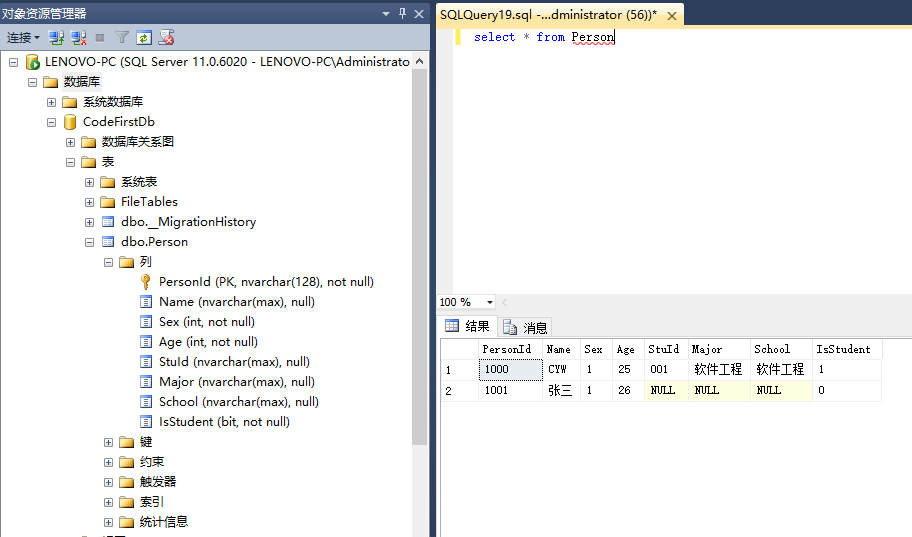
上面是两个Model生成一个表,基类和派生类都映射到同一张表中,通过使用鉴别列来识别是否为子类型。这是Code First默认规则使用的表映射方法TPH(Table Per Hierarchy)。其实还有两种映射方法。一种是TPT,一种是TPC.
TPT:Table Per Type,TPH将所有层次的类都放在了一个表里,而TPT在一个单独的表中储存来自基类的属性,在派生类定义的附加属性储存在另一个表里,并使用外键与主表相连接。这种方式只需指定子类表名。
[Table("Student")]
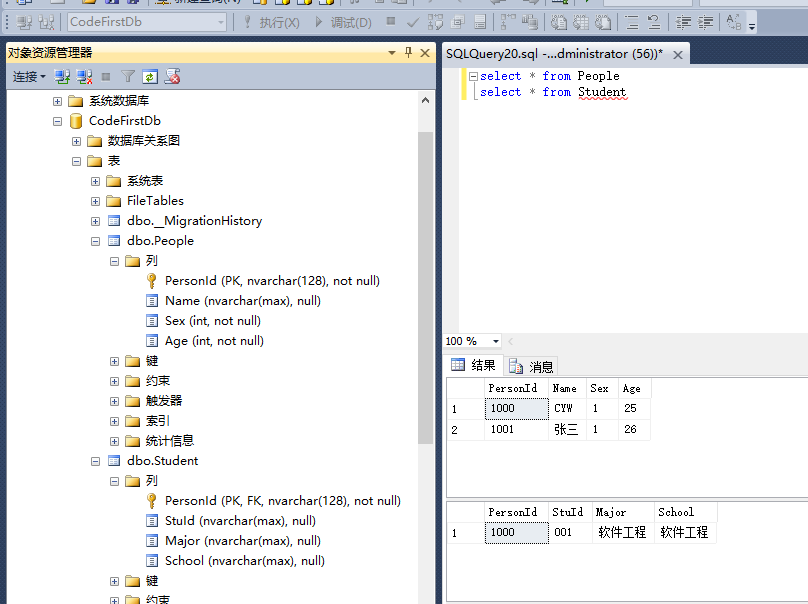
TPC:Table Per Concrete Type,基类与派生类都映射在不同的表中,不同的是派生类中还包括了基类的字段。TPC只能用Fluent API来配置
modelBuilder.Entity<Person>().Map(m => { m.ToTable("Person"); }).Map<Student>(m => { m.ToTable("Student"); m.MapInheritedProperties(); });

四、多个Model映射一个表
上面虽然是两个类Person、Student映射到一个表中,但主键都在基类上定义的,映射一个表还比较容易。如果是两个没有继承关系的Model如何映射到同一张表呢?这个我们在上面Person类Student类的基础上增加了一个IDCard类,主要是表示身份证类。假设Person的PersonId就是IDCard的PersonId。两个Model映射一个表,那两个Molde肯定是一对一的关系,映射的表名相同,主键名和类型也要相同,这些是必须的。同时还要指明两个类的外键,只指明一个都不行。
using System; using System.Collections.Generic; using System.Linq; using System.Text; using System.Threading.Tasks; using System.ComponentModel.DataAnnotations; using System.ComponentModel.DataAnnotations.Schema; namespace EFCodeFirstModels { [Table("Person")] public class IDCard { //身份证号 [Key,ForeignKey("People")] public string PersonId { get; set; } //法定出生日期 public DateTime BirthDate { get; set; } public Person People { get; set; } public IDCard(string personId, DateTime birstDate) { PersonId = personId; BirthDate = birstDate; } } }
using System; using System.Collections.Generic; using System.ComponentModel.DataAnnotations; using System.ComponentModel.DataAnnotations.Schema; using System.Linq; using System.Text; using System.Threading.Tasks; namespace EFCodeFirstModels { public enum SexType { Male, Female } [Table("Person")] public class Person { [Key, ForeignKey("Card")] public string PersonId { get; set; } //姓名 public string Name { get; set; } //性别 public SexType Sex { get; set; } //年龄 public int Age { get; set; } public IDCard Card { get; set; } public Person(string personId, string name, SexType sex, int age, IDCard card) { PersonId = personId; Name = name; Sex = sex; Age = age; Card = card; } } }
using System; using System.Collections.Generic; using System.ComponentModel.DataAnnotations; using System.ComponentModel.DataAnnotations.Schema; using System.Linq; using System.Text; using System.Threading.Tasks; namespace EFCodeFirstModels { public class Student : Person { public string StuId { get; set; } public string Major { get; set; } public string School { get; set; } public Student(string stuId, string major, string school, string personId, string name, SexType sex, int age, IDCard card) : base(personId, name, sex, age, card) { this.StuId = stuId; this.Major = major; this.School = major; this.PersonId = personId; this.Name = name; this.Sex = sex; this.Age = age; this.Card = card; } } }
在Mian中先添加一个Person来看下运行结果。
//using能及时释放资源,例如数据库连接异常,可以即使将上下文释放 using (var db=new EFCodeFirstDbContext()) { IDCard card = new IDCard("1000", DateTime.Now); Person person = new Person("1001", "张三", SexType.Female, 26, card); db.Persons.Add(person); db.SaveChanges(); Console.WriteLine("Success"); } Console.ReadLine(); }
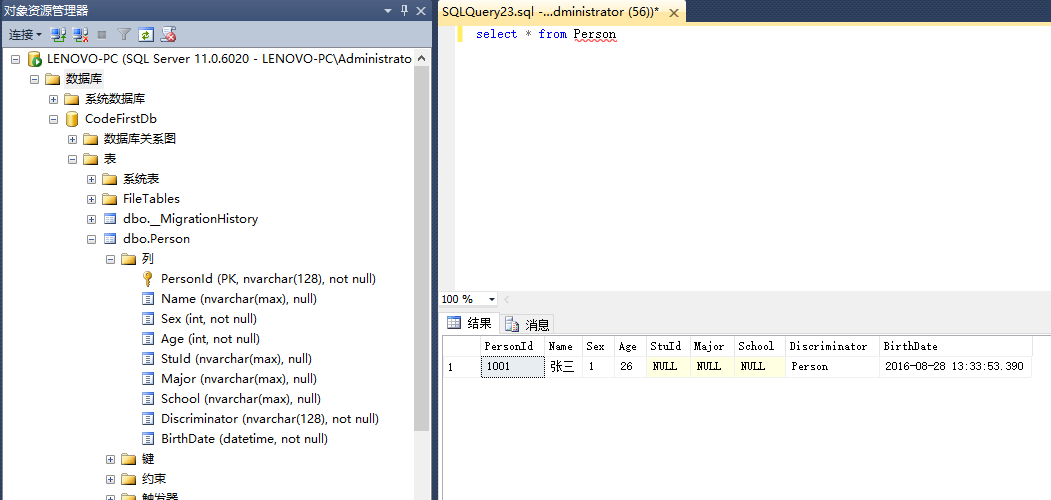
从上面的截图看到Person表中也有Student的属性,感觉真是不可思议,amazing.
我们添加一个Person一个Student来看下效果
static void Main(string[] args) { //using能及时释放资源,例如数据库连接异常,可以即使将上下文释放 using (var db=new EFCodeFirstDbContext()) { IDCard card = new IDCard("1000", DateTime.Now); Person person = new Person("1001", "张三", SexType.Female, 26, card); db.Persons.Add(person); IDCard card2 = new IDCard("1000", DateTime.Now); Student stu = new Student("001", "挖掘机", "蓝翔", "1000", "赵铁蛋", SexType.Male, 25, card2); db.Persons.Add(stu); db.SaveChanges(); Console.WriteLine("Success"); } Console.ReadLine(); }
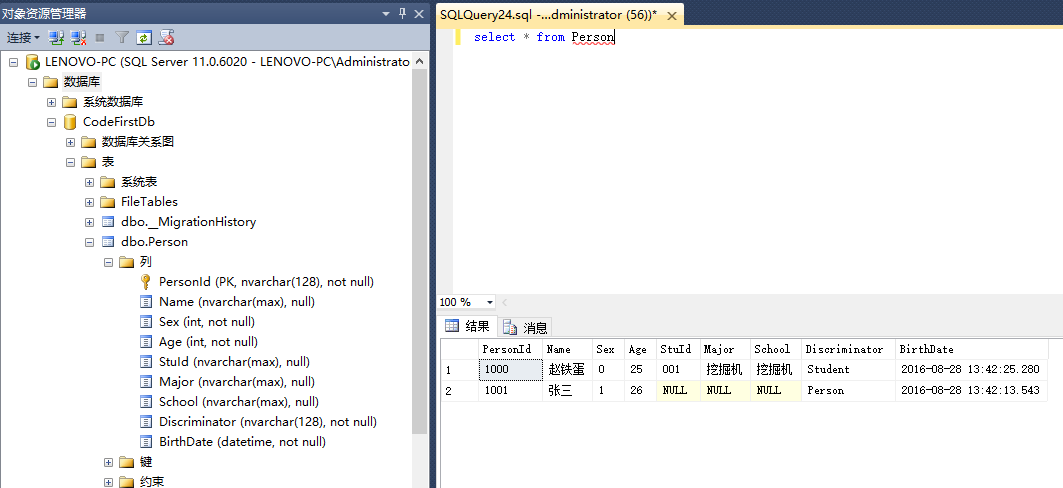
IDCard和Person生成了同一表,我们可以像上面的Fluent API来改变Discriminator列名。也可以使用TPT的方式生成两个表,只需在Student类上指明映射的表名。
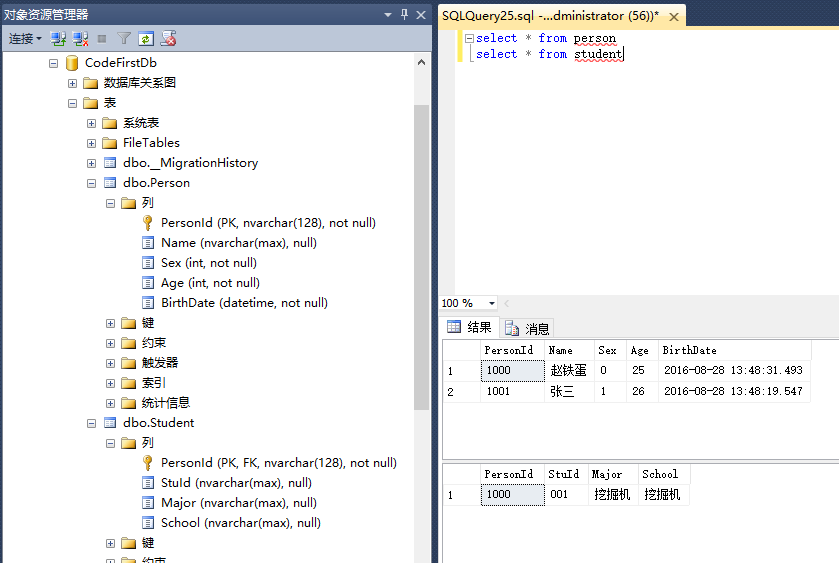
但是TPC就不行了。就会报错,这可能也是只新增Person的时候Student中的属性也会自动添加上的原因吧。
五、一个Model映射多个表
一个Model映射多个表和上面多个Model映射一个表正好反过来,还用上面Student和Person举例。
modelBuilder.Entity<Student>().Map(m=> { m.ToTable("Person"); m.Properties(p => p.PersonId); m.Properties(p=>p.Name); m.Properties(p=>p.Age); m.Properties(p => p.Sex); }).Map(m=> { m.ToTable("Student"); m.Properties(p => p.PersonId); m.Properties(p=>p.StuId); m.Properties(p => p.Major); m.Properties(p => p.School); });
上面将一个Student类映射给两个表一个Student一个person.
//using能及时释放资源,例如数据库连接异常,可以即使将上下文释放 using (var db=new EFCodeFirstDbContext()) { Person person = new Person("1001", "张三", SexType.Female, 26); db.Persons.Add(person); Student stu = new Student("001", "挖掘机", "蓝翔", "1000", "赵铁蛋", SexType.Male, 25); db.Persons.Add(stu); db.SaveChanges(); Console.WriteLine("Success"); }
我们上面添加了一个Person类对象,一个Student类对象,这是Student对象会添加到两个表中。
